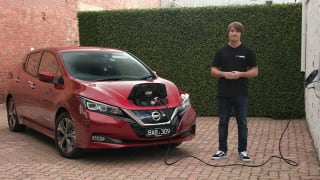
Nissan Leaf 2020 review
Nissan's Leaf is an EV smash hit in Europe, but with range and politics working against it, can it work in Australia?
Browse over 9,000 car reviews
Think of Hyundai's Ioniq as the automotive equivalent of Goldilocks (only with less bears), with the brand putting forward three different eco options in the one vehicle, meaning all you need to do is choose the one that's just right.
See, the just updated Ioniq is offered with three different powertrain options, starting with a hybrid, then a plug-in hybrid, and finally a fully electric version.
And this 2020 update has seen the addition of a bigger battery in the EV, better interior tech across the board and, less happily, higher prices no matter which one you go for.
So is the Ioniq truly a best of all worlds' proposition? Or is it a jack of all trades but master of none?
Let’s go find out.
| Hyundai Ioniq 2020: Electric Elite | |
|---|---|
| Safety rating | |
| Engine Type | — |
| Fuel Type | Electric |
| Fuel Efficiency | —L/100km |
| Seating | 5 seats |
| Price from | $39,600 |
No matter which Ioniq you opt for - be it the Hybrid, Plug-In Hybrid or Electric - you can choose between two trim levels, Elite and Premium, with prices having risen right across the board.
How much more you'll pay depends on how green you're feeling, with the cheapest Hybrid increasing by about $800, while the fully electric version has increased by $3500 - a sizeable jump, but one Hyundai justifies with the bigger 38.3kWh battery, which means a 33 per cent better range, and better cabin technology.

Exactly what you get for your hard-earned money depends on your drivetrain choice, so stick with us a moment while we unpack the details.
The Ioniq Hybrid Elite ($34,790) arrives with cloth seats, LED DRLs, a 10.25-inch multimedia (the biggest that's ever appeared in a Hyundai) screen that's both Apple CarPlay and Android Equipped, and an Infinity eight-speaker stereo. The alloys are 15 inches, and you'll find dual-zone climate control, LED DRLs, push-button start and proximity unlocking.

Opt for the Ioniq Plug-In Hybrid Elite ($41,990), and you'll add smart cruise with stop and go, bigger 16-inch alloys and electronic parking brake. Finally, the Ioniq Electric Elite ($48,490) drops the climate control to a single-zone system, but adds electric folding mirrors and rain sensing wipers and a seven-inch TFT screen in the driver's binnacle.
Stepping up the Hybrid Premium ($39,990) adds 17-inch alloy wheels, leather appointed seats, smart cruise, the seven-inch display in the driver's binnacle, LED headlights, heated and ventilated front seats and a sunroof.
The Plug-In Hybrid Premium ($46,490) shares that same extensive feature list, but drops the wheel size to 16 inches, and the Electric Premium ($52,490) again drops the climate control to a single-zone system.

Do you like the way the existing Ioniq family looks? Then boy have we got good news for you.
On the outside, expect more of a design tickle than a complete overhaul, with new headlights and a tweaked grille design headlining the changes. Otherwise, though, it's much the same.

Inside, however, the changes are both bigger and far more useable, spearheaded by the biggest multimedia screen to have ever appeared in a Hyundai vehicle - a black-framed, 10.25-inch unit that's big, clear and fairly easy to use, and that is equipped with Apple CarPlay and Android Auto to boot.
The climate control switchgear has been swapped out for a modern-feeling and backlit touch-operated unit, too, but the over-all premium-ness of the cabin does depend on your budget, with the leather-trimmed seats and big sunroof we experienced in the Premium cars really upping the interior ambience.

It's refreshingly spacious, the Ioniq, especially in the backseat. While headroom back there is adequate over ample, I found I had plenty of knee room behind my own driving position, and you can be confident of sitting two adults in the back in comfort, though three remains a stretch.
Up front, the cabin feels roomy, with little risk of awkward elbow rubbing with your front-seat passenger, with the two seats separated by a wide arm rest, and storage cubbies that double as cup or bottle holders.
The more expensive models adds wireless charging beneath the air-con controls, while only the Ionic Electric swaps out the traditional T-bar for a slightly weird-feeling push-button shift system that sits in front of a wrist pad that looks a little like a computer mouse.

The Ioniq measures 4470mm innd up to 1475mm in height, and it rides on a 2700mm wheelbase. To put that into perspective, the top-selling i30 measures in at 4340mm, 1795mm and 1455mm, so we're talking a bigger car in every dimension.
The Hybrid cars will serve up 563 lites of boot space with the rear seats in place, or a maximum 1518 litres (VDA, filled to the roof). The Plug-In Hybrid cars pay a space penalty, with 446 litres and 1401 litres, and the Electric cars deliver 462 litres and 1417 litres.

Three choices here, so let's start with the cheapest one; the Hybrid. That vehicle blends its 1.6-litre, four-cylinder petrol engine with a 32kW electric motor for combined outputs of 104kW and 265Nm. It's paired with a six-speed DCT automatic.

Next up is the Plug-In Hybrid, which pairs the same petrol engine and gearbox with a bigger electric battery to produce the same outputs (104kW and 265Nm), but delivers a pure electric driving range of up to 63 kilometres.
Finally, there's the Ioniq Electric, which ditches the petrol engine in favour of a 100kW and 295Nm electric motor, fed by a bigger-for-2020 38.3kWh battery. That power is fed through a single-speed gearbox.
The Hybrid drinks a combined 3.4-3.9L/100km, while the Hyundai describes the Plug-In Hybrid as Australia's most fuel-efficient car, with the claimed combined figure hovering at 1.1L/100km
But even that can't compete with the Electric, which drinks no fuel at all, and instead burns through electricity instead, and will deliver 311km in driving range between recharging.

And speaking of charging, you’ll get from empty to 80 per cent full in a little under an hour using a 100kW fast charger, or a little over six hours when plugged into a wall box at home.
Now, let’s start with the obvious selling point for these cars, and that is their eco-friendliness. There are faster, more athletic cars, sure. But there are few that can compete on fuel use (and in the case of the Plug-In Hybrid, at least according to Hyundai, there are none that can compare).
Our test drive was comprehensive, taking in a mix of highway, suburban and proper twisting roads, and we spent the bulk of the 200km circuit behind the wheel of the Plug-In Hybrid, so let's start there.
First, the fuel use. After some enthusiastic driving mixed with EV-only hypermiling, we were still reading an average 2.3-litres per hundred kilometres in fuel use on the trip computer. Now that's an average taken across two extremes, so it's probably also a fair representation of what you can expect in your day-to-day driving. Which means you’re getting a lot of bang for your petrol bucks.
It's an expectedly calm and mostly quiet (away from the coarse chip, with can send a drone around the cabin) drive experience, with the focus here clearly more on quiet competence than off-the-chain excitement.

There's also a strange mental affliction that befalls anyone behind the wheel of an electric vehicle, and it's one that drains the lead from your right foot and the red mist from your field of vision. Instead, you just naturally find yourself trying to eek out the most from your batteries, which is exactly what we attempted in the Plug-In Hybrid, stretching the electric-only range for as long we possibly could.
Happily, the shift between electric and engine is seamless (once the battery power gets low enough, the engine will automatically kick in on steep climbs or under heavy acceleration), but you barely notice it, and it is possible to squeeze more power into the battery through heavy use of the brakes.
The downside for me, though, was that the hybrid was missing the some of the ride and handling magic we've come to expect from modern Hyundais, with the steering feeling less than communicative, which, combined with body roll, doesn't inspire endless confidence when barrelling into corners. That said, though, how many people are taking their Plug-In Hybrid Ioniq to a race meet?
That said, the EV is a different beast from behind the wheel. Perhaps it's a lower centre of gravity, but the Ioniq Electric feels far more planted in the twisting stuff, even if it doesn't have a whole heap of grunt to pull you out the other side.

Whenever you read about EVs these days, you read about their blistering performance in a straight line, how they scream to 100km/h with all of their torque available instantly. This car, though, not so much. In fact, it’s quite leisurely. We've (very unofficially) clocked it at about nine seconds, so you’re not going to win too many red-light derbies against other EVs.
But the flip side of that is it feels more useable than those other electric cars. You don’t get that yo-yo effect when accelerating and braking. In fact, it’s far more natural feeling, much like a conventional car. And so it minimises that step from an ICE into a battery-electric vehicle.
Basic Warranty
5 years / unlimited km warranty
ANCAP Safety Rating

The standard Ioniq safety offering, even on the cheapest Hybrid model, includes seven airbags, as well as Forward Collision Avoidance with AEB, high-beam assist, lane keep assist, rear cross-traffic alert, front and rear parking sensors and a rear-view camera.
Higher spec variants in the range also get lane keep assist (LKAP) and adaptive cruise control.
The Ioniq scored a five-star ANCAP crash rating when tested in 2016.
Expect Hyundai's five-year, unlimited-kilometre warranty, with the batteries in the EV covered for a full eight years.
Servicing is required every 12 months or 15,000kms, and the brand's capped-price servicing plans see maintenance costs capped at $1525 for the first five years of ownership for the Hybrid and Plug-In Hybrid models. The Electric is even cheaper, costing just $800 for the first five years of ownership.

That eco-friendly cars have ceased being the answer for tomorrow, and are instead a solution for today, will hardly comes as news. We are now utterly spoiled for choice when it comes to minimising our fuel use.
But the fact you can choose from almost all those options in the one car is still pretty unique, and Hyundai deserves kudos for offering the Ioniq with three future-facing drivetrains.
But they deserve even more kudos for delivering an eco-friendly vehicle that is both family friendly and endlessly useable in everyday life.
| Vehicle | Specs | Price* | |
|---|---|---|---|
| Hybrid Elite | 1.6L, Hyb/ULP, 6 SP DUAL-CLUTCH AUTO | $27,610 – 33,330 | 2020 Hyundai IONIQ 2020 Hybrid Elite Pricing and Specs |
| Plug-IN Hybrid Elite | 1.6L, Hyb/ULP, 6 SP DUAL-CLUTCH AUTO | $33,770 – 40,260 | 2020 Hyundai IONIQ 2020 Plug-IN Hybrid Elite Pricing and Specs |
| Electric Elite | —, Electric, 1 SP AUTO | $39,600 – 46,530 | 2020 Hyundai IONIQ 2020 Electric Elite Pricing and Specs |
| Electric Premium | —, Electric, 1 SP AUTO | $43,340 – 50,380 | 2020 Hyundai IONIQ 2020 Electric Premium Pricing and Specs |
| Price and features | 8 |
|---|---|
| Design | 7 |
| Practicality | 7 |
| Under the bonnet | 8 |
| Efficiency | 9 |
| Driving | 7 |
| Safety | 8 |
| Ownership | 8 |
$39,600
Lowest price, based on third party pricing data